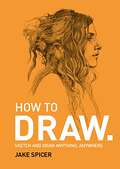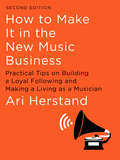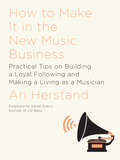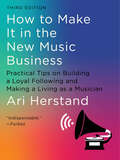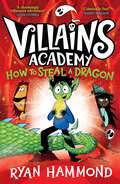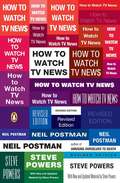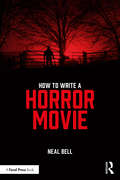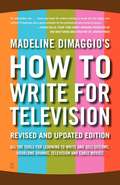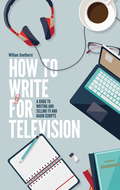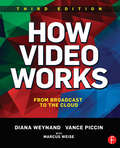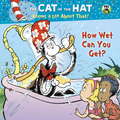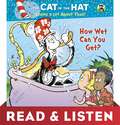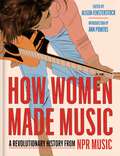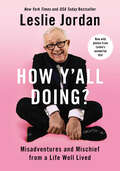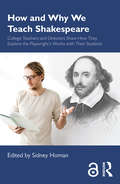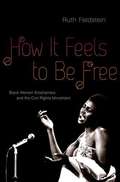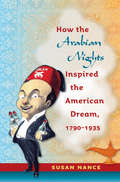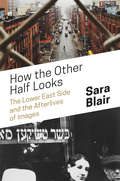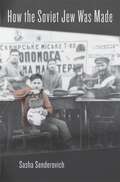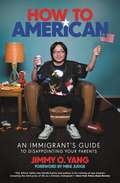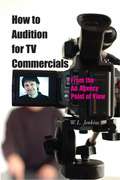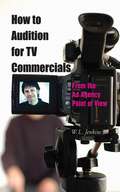- Table View
- List View
How To Draw: Sketch and draw anything, anywhere with this inspiring and practical handbook
by Jake SpicerJake Spicer wants you to learn how to draw. This is his complete course in drawing, suitable for complete beginners as well as experienced artists, and designed to help you fit drawing into your lifestyle. Tried-and-tested exercises, ranging from five-minute sketches to dedicated sessions of an hour or longer, cover every subject and location you could wish for, while accessibly written drawing theory helps you relate the technical concepts to your practice, helping you to hone your craft. Whatever your goals are, expert art tutor Jake Spicer gives you the inspiration and encouragement to draw more - and keep improving.
How To Go Vegan: The why, the how, and everything you need to make going vegan easy
by Veganuary Trading LimitedA short guide to going vegan - the why, the what and the how.Ever thought about eating less meat and fewer dairy products? Concerned about animal welfare and the environment? Interested in the health benefits of a plant-based lifestyle? This is the book for you. In this fun, easy to follow and informative guide, the team behind the charity Veganuary provide everything you need to make changes towards leading a healthier, more ethical and sustainable lifestyle. From your motivations, tips for eating out, easy substitutions and making sure you get the right nutrients, this book is a lifesaver for vegans, those wanting to give veganism a try, or for friends and family. Try going vegan for one month - with How To Be Vegan it is easier than you think.(P)2017 Hodder & Stoughton
How To Make It in the New Music Business (Second Edition): Practical Tips On Building A Loyal Following And Making A Living As A Musician
by Ari HerstandHailed as an “indispensable” guide (Forbes), How to Make It in the New Music Business returns in this extensively revised and expanded edition. When How to Make It in the New Music Business hit shelves in 2016, it instantly became the go-to resource for musicians eager to make a living in a turbulent industry. Widely adopted by music schools everywhere and considered “the best how- to book of its kind” (Music Connection), it inspired thousands to stop waiting around for that “big break.” Now trusted as the leading expert for “do it yourself” artists, Ari Herstand returns with this second edition, maintaining that a stable career can be built by taking advantage of the many tools at our fi ngertips: conquering social media, mastering the art of merchandising, embracing authentic fan connection, and simply learning how to persevere. Comprehensively updated to include the latest online trends and developments, it offers inspiring success stories across media such as Spotify and Instagram. The result is a must- have for anyone hoping to navigate the increasingly complex yet advantageous landscape that is the modern music industry.
How To Make It in the New Music Business: Practical Tips On Building A Loyal Following And Making A Living As A Musician
by Derek Sivers Ari Herstand"Ari is at the front of the front. He gets it. I've read a hundred how-to-make-it-in-the-music-biz books, and this one is today's definitive, comprehensive manual." —Jack Conte, 150+ million YouTube views, Pomplamoose, CEO of Patreon Forget everything you think you know about the odds of “making it” in the music industry. Today, odds mean nothing and success is not about lucky breaks. It’s about conquering social media, mastering the art of merchandising and simply working harder and being smarter than everyone else. We are living in the midst of an industry renaissance, one that has left the record companies desperately struggling to maintain their prominence, as a subculture of dedicated, DIY (do-it-yourself) musicians have taken over. These days talent is a given and success has to be earned. In 2008, Ari Herstand boldly turned in his green Starbucks apron to his manager, determined to make a living off his craft as a singer/songwriter. Almost a decade later, he has become a founding member of the new DIY movement and a self-sustaining musician, all without the help of a major label. Now, drawing from years of experience, Herstand has written the definitive guide for other like-minded artists, the ones who want to forge their own path and not follow the traditional markers of success, like record sales, hits on the radio or the amount of your label advance. Incredibly comprehensive and brutally honest throughout, How to Make It in the New Music Business covers every facet of the "new" business, including how to: Build a grass-roots fan base—and understand the modern fan Book a profitable tour, and tips for playing live, such as opening vs. headlining etiquette, and putting on a memorable show Become popular on YouTube, Spotify and SoundCloud Get songs placed in film and television Earn royalties you didn’t know existed and reach your crowdfunding goals Musicians will not only be introduced to all the tools available today but will be shown how to effectively leverage them to actually make money. More important, they will develop the mindset to be aware of new advancements both online and in the real world and always stay in tune with a constantly evolving landscape. There has never been a better time to be an independent musician. Today, fans can communicate with their idols by simply picking up their phones, artists are able to produce studio-worthy content from their basement and albums are funded not by "record men" but by generous, engaged supporters. As result, How to Make It in the New Music Business is a must-have guide for anyone hoping to navigate the increasingly complex yet advantageous landscape that is the modern music industry.
How To Make It in the New Music Business: Practical Tips on Building a Loyal Following and Making a Living as a Musician (Third)
by Ari HerstandNow Magazine: “Top 5 Music Business Books” Hailed as an “indispensable” guide (Forbes), How to Make It in the New Music Business returns in a significantly revised and expanded third edition. How to Make It in the New Music Business, since its first publication in 2016,?has become the go-to resource for musicians eager to make a living in a turbulent industry. Widely adopted by ambitious individuals and music schools across the world and considered “the best how-to book of its kind” (Music Connection), this essential work has inspired tens of thousands of aspiring artists to stop waiting around for that “big break” and take matters into their own hands. In this highly anticipated new edition, Ari Herstand reveals how to build a profitable career with the many tools at our fingertips in the post-COVID era and beyond, from conquering social media and mastering the digital landscape to embracing authentic fan connection and simply learning how to persevere. This edition breaks down these phenomena and more, resulting in a timeless must-have for anyone hoping to navigate the increasingly complex yet advantageous landscape that is the modern music business.
How To Steal a Dragon: The perfect read this Halloween! (Villains Academy #2)
by Ryan HammondBeing BAD has never felt so GOOD! The second book in the villainously funny, highly illustrated young middle-grade series from author-illustrator Ryan Hammond. For fans of Amelia Fang, Dog Man and Grimwood. Don&’t miss the third installment, How to Win the Gruesome Games, out in April 2024! &‘A charmingly villainous adventure about friendship, school and unspeakable evil.&’ Louie Stowell, author of Loki: A Bad God&’s Guide to Being Good &‘Criminally fun!&’ Danny Wallace, author of The Day the Screens Went Blank It&’s the start of the winter term and there&’s a new teacher in town at Villains Academy – the notorious dragon-rider Felix Frostbite. Class Z are in awe of him and his lessons on venomous beasts and mythical creatures, but werewolf Bram is suspicious. Soon Bram and his friends the Cereal Killers uncover Felix Frostbite&’s evil plan to steal all the dragons from the Wicked Woods and leave Villains Academy undefended. Have the gang learnt enough to outsmart their troublesome teacher, or will Felix Frostbite&’s heist go down in villain history?PRAISE FOR VILLAINS ACADEMY: &‘Frightfully fun – Villains Academy had me cackling from the very first page!&’ Katie Tsang, co-author of the Dragon Realm series &‘I loved the spookily funny Villains Academy. It's a work of (evil) genius!&’ Jenny McLachlan, author of The Land of Roar &‘Heart-warming and hilarious – Villains Academy is a spookalicious treat, set to terrify every other book on your shelf.&’ Jack Meggitt-Phillips, author of The Beast and the Bethany &‘An absolute HOOT! Evil laughs aplenty!&’ Sophy Henn, author and illustrator of the Pizazz series &‘A joyful hug of a book with genuine warmth and heart.&’ Hannah Gold, author of The Last Bear &‘A delightfully fun adventure with real heart and humour.&’ Benjamin Dean, author of Me, My Dad and the End of the Rainbow &‘Immersive, funny, and with a cast of scarily loveable characters, Villains Academy made me feel like I was IN the book!&’ Mel Taylor-Bessent, author of The Christmas Carrolls &‘A fabulously funny adventure. I want to enrol in Villains Academy!&’ Nick Sheridan, author of The Case of the Runaway Brain &‘Wickedly funny and full of quirky yet loveable characters.&’ Iona Rangeley, author of Einstein the Penguin &‘This is a brilliant, bonkers work packed with top-notch illustration.&’ Jack Noel, author and illustrator of the Comic Classics series &‘Full of wonderful characters, Villains Academy is such a FUN read!&’ Rikin Parekh, illustrator of The Worst Class in the World series
How To Watch TV News
by Neil Postman Steve PowersA scathing and prescient look at television news,now updated for the new tech-savvy generation Television news : genuine information or entertainment fodder? Fifteen years ago, Neil Postman, a pioneer in media education and author of the bestselling Amusing Ourselves to Death, and Steve Powers, an award-winning broadcast journalist, concluded that anyone who relies exclusively on their television for accurate world news is making a big mistake. A cash cow laden with money from advertisers, so-called news shows glut viewers with celebrity coverage at the cost of things they really should know. Today, this message is still appallingly true but the problems have multiplied? along with the power of the Internet and the abundance of cable channels. A must-read for anyone concerned with the way media is manipulating our worldview, this newly revised edition addresses the evolving technology and devolving quality of America?s television news programming.
How To Write A Horror Movie
by Neal BellHow to Write a Horror Movie is a close look at an always-popular (but often disrespected) genre. It focuses on the screenplay and acts as a guide to bringing scary ideas to cinematic life using examples from great (and some not-so-great) horror movies.Author Neal Bell examines how the basic tools of the scriptwriter’s trade - including structure, dialogue, humor, mood, characters, and pace – can work together to embody personal fears that will resonate strongly on screen. Screenplay examples include classic works such as 1943’s I Walked With A Zombie and recent terrifying films that have given the genre renewed attention like writer/director Jordan Peele’s critically acclaimed and financially successful Get Out. Since fear is universal, the book considers films from around the world including the ‘found-footage’ [REC] from Spain (2007), the Swedish vampire movie, Let The Right One In (2008) and the Persian-language film Under The Shadow (2016). The book provides insights into the economics of horror-movie making, and the possible future of this versatile genre. It is the ideal text for screenwriting students exploring genre and horror, and aspiring scriptwriters who have an interest in horror screenplays.
How To Write For Television
by Madeline DimaggioTV Writing the Right Way! In this guide for every student of the small screen and every scriptwriter dreaming of breaking into the business, writer-producer Madeline DiMaggio hands you the tools of the trade. With dozens of examples from today's hit shows, as well as perennial classics, DiMaggio walks readers through the scriptwriting process, from learning how to watch TV like a writer to developing your script, pitching it, and eventually sealing the deal. DiMaggio answers the questions on every aspiring television writer's mind, with chapters on: The tools of scriptwriting Hooks that sell Creating the pilot Developing the episode, step by step How to create riveting characters Writing long form and cable movies Adaptations and collaborations Marketing your script DiMaggio combines her own experience with advice to writers from others in the trade, including agents, producers, animators, and more. This readable, reliable book has been a trusted reference for nearly two decades and is now revised to include the most up-to-date information from today's television climate, from writing for cable, reality, and TV-movie formats to the ever-evolving face of the sitcom. A must-read for anyone aiming to write for TV, How to Write for Television will continue to help budding writers reach their small-screen goals and will prepare them for working in the rapidly changing world of TV.
How To Write For Television 7th Edition: A guide to writing and selling TV and radio scripts
by William SmethurstThis book provides professional tips and techniques for those wishing to break into writing for TV whether it's a soap, series drama, or situation comedy. It covers all aspects of script writing such as structure, plotting, characterization and dialogue and is packed with advice on presenting and selling scripts. It also includes a chapter specifically on writing for radio.
How Video Works: From Broadcast to the Cloud
by Diana Weynand Vance PiccinHow Video Works raises the curtain on how video is created, scanned, transmitted, stored, compressed, encoded, delivered and streamed to its multitude of destinations. In today's digital world, every content creator--individual as well as network or corporation--must understand the process of how video works in order to deliver not only the best quality video, but a digital video file with the most appropriate specifications for each particular use. This complete guide covers key stages of video development, from image capture to the final stages of delivery and archiving, as well as workflows and new technologies, including Ultra High Definition, metadata, signal monitoring, streaming and managing video files - all presented in an easy to understand way. Whether you are a professional or new video technician discovering the ins and outs of digital distribution, this book has the information you need to succeed. The updated third edition contains: * New sections on image capture as well as streaming and video workflows * A hands-on approach to using digital scopes and monitoring the video signal * Thorough explanations of managing video files, including codecs and wrappers * In-depth coverage of compression, encoding, and metadata * A complete explanation of video and audio standards, including Ultra HD * An overview of video recording and storage formats * A complete glossary of terms for video, audio and broadcast
How Wet Can You Get? (Pictureback(R))
by Joe Mathieu Aristides Ruiz Tish RabeSally and Nick are playing in the rain--and getting really muddy! So when the Cat in the Hat offers to show them how animals get clean, the kids are keen to find out. But can Sally and Nick really get rid of the mud by taking dust baths, like a sparrow? Or by licking themselves, like a lion? And where are they going to find an oxpecker to pick it off them, like a hippo has? (Besides, oxpeckers tickle!) Maybe there's a better way for a kid to get clean? Based on an episode of the new PBS Kids program The Cat in the Hat Knows a Lot About That!, this 16-page Pictureback comes with a sheet of adorable stickers featuring all the mud encrusted characters.
How Wet Can You Get? (Pictureback(R))
by Tish RabeRead and listen along with the Cat in the Hat! Sally and Nick are playing in the rain—and getting really muddy! So when the Cat in the Hat offers to show them how animals get clean, the kids are keen to find out. But can Sally and Nick really get rid of the mud by taking dust baths, like a sparrow? Or by licking themselves, like a lion? And where are they going to find an oxpecker to pick it off them, like a hippo has? (Besides, oxpeckers tickle!) Maybe there's a better way for a kid to get clean? Based on an episode of the hit PBS Kids tv show The Cat in the Hat Knows a Lot About That!This ebook includes Read & Listen audio narration.
How Women Made Music: A Revolutionary History from NPR Music
by National Public Radio, Inc Alison FensterstockDrawn from NPR Music’s acclaimed, groundbreaking series Turning the Tables, the definitive book on the vital role of Women in Music—from Beyoncé to Odetta, Taylor Swift to Joan Baez, Joan Jett to Dolly Parton—featuring archival interviews, essays, photographs, and illustrations.Turning the Tables, launched in 2017, has revolutionized recognition of female artists, whether it be in best album lists or in the Rock and Roll Hall of FameHow Women Made Music: A Revolutionary History from NPR Music brings this impressive reshaping to the page and includes material from more than fifty years of NPR’s coverage plus newly commissioned work. A must-have for music fans, songwriters, feminist historians, and those interested in how artists think and work, including: • Joan Baez talking about nonviolence as a musical principle in 1971• Dolly Parton’s favorite song and the story behind it • Patti Smith describing art as her “jealous mistress” in 1974• Nina Simone, in 2001, explaining how she developed the edge in her voice as a tool against racism.• Taylor Swift talking about when she had no idea if her musical career might work• Odetta on how shifting from classical music to folk allowed her to express her fury over Jim Crow This incomparable hardcover volume is a vital record of history destined to become a classic and a great gift for any music fan or creative thinker.
How Y'all Doing?: Misadventures and Mischief from a Life Well Lived
by Leslie JordanViral sensation and Emmy Award-winner Leslie Jordan regales fans with entertaining stories about the odd, funny, and unforgettable events in his life in this unmissable essay collection that echoes his droll, irreverent voice. <P><P>When actor Leslie Jordan learned he had “gone viral,” he had no idea what that meant or how much his life was about to change. On Instagram, his uproarious videos have entertained millions and have made him a global celebrity. Now, he brings his bon vivance to the page with this collection of intimate and sassy essays. <P><P>Bursting with color and life, dripping with his puckish Southern charm, How Y’all Doing? is Leslie doing what Leslie does best: telling stories that make us laugh and lift our spirits even in the darkest days. Whether he’s writing about his brush with a group of ruffians in a West Hollywood Starbucks, or an unexpected phone call from legendary Hollywood start Debbie Reynolds, Leslie infuses each story with his fresh and saucy humor and pure heart. <P><P>How Y’all Doing? is an authentic, warm, and joyful portrait of an American Sweetheart— a Southern Baptist celebutante, first-rate raconteur, and keen observer of the odd side of life whose quirky wit rivals the likes of Amy Sedaris, Jenny Lawson, David Rakoff, and Sarah Vowell. <P><P><b>A New York Times Best Seller</b>
How and Why We Teach Shakespeare: College Teachers and Directors Share How They Explore the Playwright’s Works with Their Students
by Sidney HomanIn How and Why We Teach Shakespeare, 19 distinguished college teachers and directors draw from their personal experiences and share their methods and the reasons why they teach Shakespeare. The collection is divided into four sections: studying the text as a script for performance; exploring Shakespeare by performing; implementing specific techniques for getting into the plays; and working in different classrooms and settings. The contributors offer a rich variety of topics, including: working with cues in Shakespeare, such as line and mid-line endings that lead to questions of interpretation seeing Shakespeare’s stage directions and the Elizabethan playhouse itself as contributing to a play’s meaning using the "gamified" learning model or cue-cards to get into the text thinking of the classroom as a rehearsal playing the Friar to a student’s Juliet in a production of Romeo and Juliet teaching Shakespeare to inner-city students or in a country torn by political and social upheavals. For fellow instructors of Shakespeare, the contributors address their own philosophies of teaching, the relation between scholarship and performance, and—perhaps most of all—why in this age the study of Shakespeare is so important.
How it Feels to be Free: Black Women Entertainers and the Civil Rights Movement
by Ruth FeldsteinIn 1964 Nina Simone sat at a piano in New York's Carnegie Hall to play what she called a "show tune." Then she began to sing: "Alabama's got me so upset / Tennessee made me lose my rest / And everybody knows about Mississippi Goddam!" Simone, and her song, became icons of the civil rights movement. But her confrontational style was not the only path taken by black women entertainers. In How It Feels to Be Free, Ruth Feldstein examines celebrated black women performers, illuminating the risks they took, their roles at home and abroad, and the Ways that they raised the issue of gender amid their demands for black liberation. Feldstein focuses on six women who made names for themselves in the music, film, and television industries: Nina Simone, Lena Horne, Miriam Makeba, Abbey Lincoln, Diahann Carroll, and Cicely Tyson. These women did not simply mirror black activism; their performances helped constitute the era's political history. Makeba connected America's struggle for civil rights to the fight against apartheid in South Africa, while Simone sparked high-profile controversy with her incendiary lyrics. Yet Feldstein finds nuance in their careers. In 1968, Hollywood cast the outspoken Lincoln as a maid to a white family in For Love of Ivy, adding a layer of complication to the film. That same year, Diahann Carroll took on the starring role in the television series Julia. Was Julia a landmark for casting a black woman or for treating her race as unimportant? The answer is not clear-cut. Yet audiences gave broader meaning to what sometimes seemed to be apolitical performances. How It Feels to Be Free demonstrates that entertainment was not always just entertainment and that "We Shall Overcome" was not the only soundtrack to the civil rights movement. By putting black women performances at center stage, Feldstein sheds light on the meanings of black womanhood in a revolutionary time.
How the Arabian Nights Inspired the American Dream, 1790-1935
by Susan NanceAmericans have always shown a fascination with the people, customs, and legends of the "East"--witness the popularity of the stories of theArabian Nights, the performances of Arab belly dancers and acrobats, the feats of turban-wearing vaudeville magicians, and even the antics of fez-topped Shriners. In this captivating volume, Susan Nance provides a social and cultural history of this highly popular genre of Easternized performance in America up to the Great Depression. According to Nance, these traditions reveal how a broad spectrum of Americans, including recent immigrants and impersonators, behaved as producers and consumers in a rapidly developing capitalist economy. In admiration of theArabian Nights, people creatively reenacted Eastern life, but these performances were also demonstrations of Americans' own identities, Nance argues. The story of Aladdin, made suddenly rich by rubbing an old lamp, stood as a particularly apt metaphor for how consumer capitalism might benefit each person. The leisure, abundance, and contentment that many imagined were typical of Eastern life were the same characteristics used to define "the American dream. " The recent success of Disney'sAladdinmovies suggests that many Americans still welcome an interpretation of the East as a site of incredible riches, romance, and happy endings. This abundantly illustrated account is the first by a historian to explain why and how so many Americans sought out such cultural engagement with the Eastern world long before geopolitical concerns became paramount.
How the Other Half Looks: The Lower East Side and the Afterlives of Images
by Sara BlairHow New York’s Lower East Side inspired new ways of seeing AmericaNew York City's Lower East Side, long viewed as the space of what Jacob Riis notoriously called the "other half," was also a crucible for experimentation in photography, film, literature, and visual technologies. This book takes an unprecedented look at the practices of observation that emerged from this critical site of encounter, showing how they have informed literary and everyday narratives of America, its citizens, and its possible futures.Taking readers from the mid-nineteenth century to the present, Sara Blair traces the career of the Lower East Side as a place where image-makers, writers, and social reformers tested new techniques for apprehending America--and their subjects looked back, confronting the means used to represent them. This dynamic shaped the birth of American photojournalism, the writings of Stephen Crane and Abraham Cahan, and the forms of early cinema. During the 1930s, the emptying ghetto opened contested views of the modern city, animating the work of such writers and photographers as Henry Roth, Walker Evans, and Ben Shahn. After World War II, the Lower East Side became a key resource for imagining poetic revolution, as in the work of Allen Ginsberg and LeRoi Jones, and exploring dystopian futures, from Cold War atomic strikes to the death of print culture and the threat of climate change.How the Other Half Looks reveals how the Lower East Side has inspired new ways of looking—and looking back—that have shaped literary and popular expression as well as American modernity.
How the People Sang the Mountains Up: How and Why Stories
by Maria LeachThis book tells some of the most famous how and why stories, such as Why Rabbit has a Short Tail?, How the Horse was created?, and Why man has dogs? These stories are collected from around the world and in many different cultures. There is a bibliography and notes on the different stories. Delightful book for all ages.
How the Soviet Jew Was Made
by Sasha SenderovichA close reading of postrevolutionary Russian and Yiddish literature and film recasts the Soviet Jew as a novel cultural figure: not just a minority but an ambivalent character navigating between the Jewish past and Bolshevik modernity.The Russian Revolution of 1917 transformed the Jewish community of the former tsarist empire. In particular, the Bolshevik government eliminated the requirement that most Jews reside in the Pale of Settlement in what had been Russia’s western borderlands. Many Jews quickly exited the shtetls, seeking prospects elsewhere. Some left for bigger cities, others for Europe, America, or Palestine. Thousands tried their luck in the newly established Jewish Autonomous Region in the Far East, where urban merchants would become tillers of the soil. For these Jews, Soviet modernity meant freedom, the possibility of the new, and the pressure to discard old ways of life.This ambivalence was embodied in the Soviet Jew—not just a descriptive demographic term but a novel cultural figure. In insightful readings of Yiddish and Russian literature, films, and reportage, Sasha Senderovich finds characters traversing space and history and carrying with them the dislodged practices and archetypes of a lost Jewish world. There is the Siberian settler of Viktor Fink’s Jews in the Taiga, the folkloric trickster of Isaac Babel, and the fragmented, bickering family of Moyshe Kulbak’s The Zemlenyaners, whose insular lives are disrupted by the march of technological, political, and social change. There is the collector of ethnographic tidbits, the pogrom survivor, the émigré who repatriates to the USSR.Senderovich urges us to see the Soviet Jew anew, as not only a minority but also a particular kind of liminal being. How the Soviet Jew Was Made emerges as a profound meditation on culture and identity in a shifting landscape.
How to American: An Immigrant's Guide to Disappointing Your Parents
by Jimmy O. Yang Mike JudgeStandup comic, actor and fan favorite from the popular HBO series Silicon Valley shares his memoir of growing up as a Chinese immigrant in California and making it in Hollywood."I turned down a job in finance to pursue a career in stand-up comedy. My dad thought I was crazy. But I figured it was better to disappoint my parents for a few years than to disappoint myself for the rest of my life. I had to disappoint them in order to pursue what I loved. That was the only way to have my Chinese turnip cake and eat an American apple pie too."Jimmy O. Yang is a standup comedian, film and TV actor and fan favorite as the character Jian Yang from the popular HBO series Silicon Valley. In How to American, he shares his story of growing up as a Chinese immigrant who pursued a Hollywood career against the wishes of his parents: Yang arrived in Los Angeles from Hong Kong at age 13, learned English by watching BET RapCity for three hours a day, and worked as a strip club DJ while pursuing his comedy career. He chronicles a near deportation episode during a college trip Tijuana to finally becoming a proud US citizen ten years later. Featuring those and many other hilarious stories, while sharing some hard-earned lessons, How to American mocks stereotypes while offering tongue in cheek advice on pursuing the American dreams of fame, fortune, and strippers.
How to Audition for TV Commercials
by W. L. JenkinsWhat do ad agencies look for when casting TV commercials? This insider's guide, written by a former actor turned ad agency exec, has the answers. It provides step-by-step instructions to help actors understand and master the entire process, from assessing one's looks and personality to the agency preproduction process, from reading scripts and understanding storyboards to preparing for the audition, doing the shoot, and more.
How to Audition for TV Commercials: From the Ad Agency Point of View
by W. L. JenkinsWhat do ad agencies look for when casting TV commercials? This insider's guide, written by a former actor turned ad agency exec, has the answers. It provides step-by-step instructions to help actors understand and master the entire process, from assessing one's looks and personality to the agency preproduction process, from reading scripts and understanding storyboards to preparing for the audition, doing the shoot, and more.Allworth Press, an imprint of Skyhorse Publishing, publishes a broad range of books on the visual and performing arts, with emphasis on the business of art. Our titles cover subjects such as graphic design, theater, branding, fine art, photography, interior design, writing, acting, film, how to start careers, business and legal forms, business practices, and more. While we don't aspire to publish a New York Times bestseller or a national bestseller, we are deeply committed to quality books that help creative professionals succeed and thrive. We often publish in areas overlooked by other publishers and welcome the author whose expertise can help our audience of readers.
